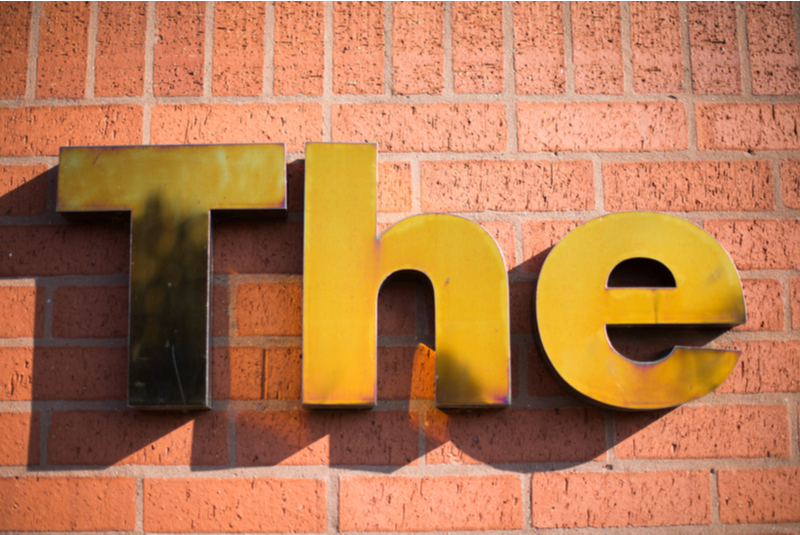¿Cuándo debemos utilizar el artículo THE en inglés?
¿Cuándo debemos utilizar el artículo THE en inglés?
¿Te da mucho problema la utilización del llamado artículo definido (definite article) THE? Aquí te lo explicamos de una manera muy simple para que lo aprendas a utilizar correctamente.
Primero, debemos saber que el artículo definido the es considerada la palabra más frecuente en inglés y se utiliza delante de un sustantivo cuando creemos que nuestro oyente o lector sabe exactamente a qué nos referimos o ya hay una referencia al respecto por distintas situaciones o motivos:

Por ejemplo…
Porque solo existe uno en su tipo o posición:
The Pope is visiting our country next year.
The sun is astonishingly bright today, don’t you think?
Who was the president of our country 50 years ago?
Esta es la misma razón por la cual usamos el artículo definido cuando tenemos un adjetivo superlativo (superlative adjective):
She is the tallest girl in her family.
This is said to be the oldest building in the city.
También lo utilizamos porque solo existe uno en un contexto específico:
We live in a small house next to the church. (= the church in our hometown)
Dad, can I borrow the car? (= the car our family possesses)
When we stayed at our cousins’ appartment, we went to the beach every day. (= the beach near my cousins’ appartment)
Look at the girls over there. (= the girls I am pointing at)
Como mencionamos al inicio, porque ya hay referencia previa o contexto:
A young man proposed his girlfriend right in front of everyone at the restaurant (the one we were at). The man showed a really shiny ring.
También lo utilizamos para comentar algo acerca de todas las cosas a las que se refiere un sustantivo como especie:
The dog is not really a dangerous animal. (= Dogs are not really dangerous animals.)
The koala is found only in Australia. (= Koalas are found only in Australia.)
The heart pumps blood around the body. (= Hearts pump blood around bodies.)

Utilizamos el artículo definido para hablar de instrumentos musicales:
Daphne plays the piano really well. (NOT Daphne plays piano…)
She is learning the guitar. (NOT She is learning guitar.)
Cuando nos referimos a un sistema o servicio:
Why are they shutting down the subway?
They were speaking about that on the radio.
Maybe we should call the police.
También podemos utilizar el artículo definido con adjetivos como rich, poor, elderly y unemployed para hablar de grupos de personas:
Life must be really hard for the poor.
In my opinion, the rich should pay more taxes.
She works for an organization which helps the disabled.
Hablemos de THE con nombres propios:
Normalmente no utilizamos el artículo definido con los nombres:
William Shakespeare wrote Hamlet.
Paris is the capital of France.
Turkey is partly in Asia.
Sin embargo, sí usamos el artículo definido en estos casos:
Para referirnos a países cuyos nombres incluyen palabras como kingdom, states o republic:
The United States of America
The United Kingdom
The Czech Republic
También lo utilizamos con países que tienen nombres en plural:
The Netherlands
The Philippines
También cuando hablamos de accidentes geográficos, como cordilleras, grupos de islas, ríos, mares, océanos y canales:
the Himalayas
the Panama Canal
the Atlantic Ocean

También al referirnos a periódicos, diarios, obras de arte y edificios que son muy conocidos o renombrados, organizaciones o nombres de hoteles, bares y restaurantes:
The Washington Post / The United Nations
The National Enquirer / The Waldorf Astoria
The Empire State Building / The Déjà Vu
The Trump Tower / The Temple Bar Pub
The Mona Lisa / The Cavern
The Starry Night / The Last Supper
Pero hay que tener en cuenta que no utilizamos el artículo definido si el nombre del hotel o restaurante es el nombre del propietario:
Wendy’s
Alessandro’s
Alessandro’s Bistró
Y finalmente, utilizamos the para hablar de familias (y toma en cuenta el detalle de que a diferencia del español, tenemos que pluralizar el nombre a menos que incluyas la palabra family después del nombre):
The Simpsons (no The Simpson / sí The Simpson family)
The Jacksons (no The Jackson / sí The Jackson family)
The Clintons (no The Clinton / sí The Clinton family)


